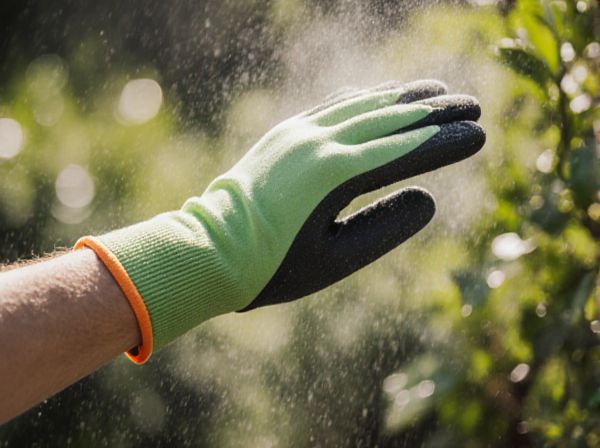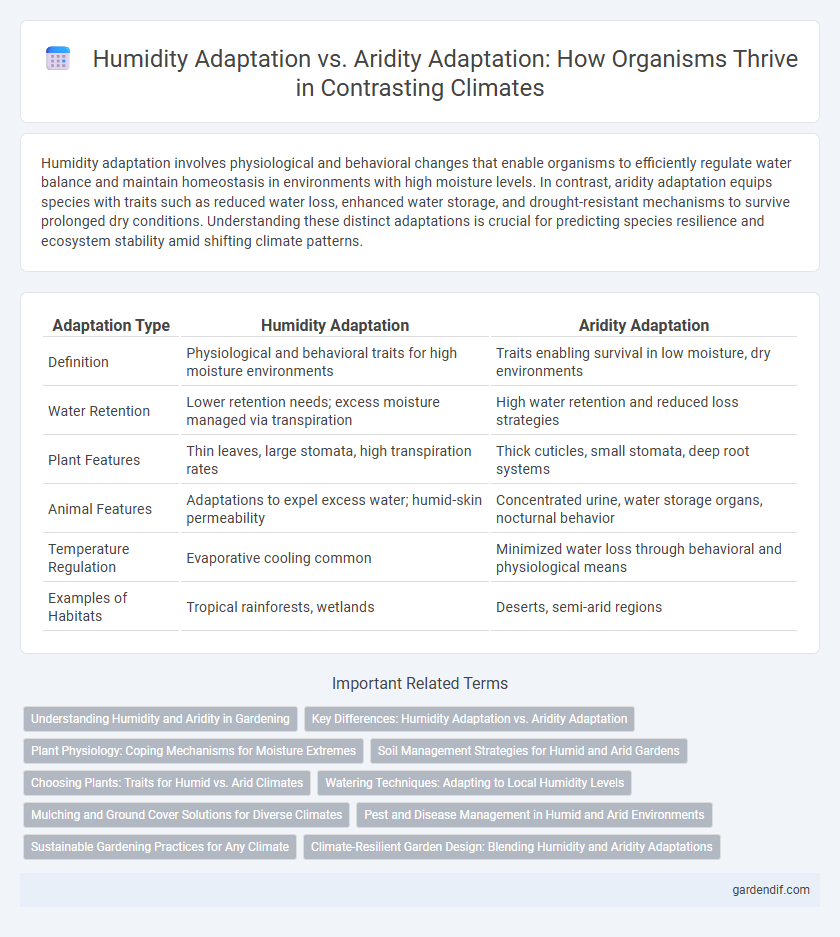
Humidity adaptation vs Aridity adaptation Illustration
Humidity adaptation involves physiological and behavioral changes that enable organisms to efficiently regulate water balance and maintain homeostasis in environments with high moisture levels. In contrast, aridity adaptation equips species with traits such as reduced water loss, enhanced water storage, and drought-resistant mechanisms to survive prolonged dry conditions. Understanding these distinct adaptations is crucial for predicting species resilience and ecosystem stability amid shifting climate patterns.
Table of Comparison
| Adaptation Type | Humidity Adaptation | Aridity Adaptation |
|---|---|---|
| Definition | Physiological and behavioral traits for high moisture environments | Traits enabling survival in low moisture, dry environments |
| Water Retention | Lower retention needs; excess moisture managed via transpiration | High water retention and reduced loss strategies |
| Plant Features | Thin leaves, large stomata, high transpiration rates | Thick cuticles, small stomata, deep root systems |
| Animal Features | Adaptations to expel excess water; humid-skin permeability | Concentrated urine, water storage organs, nocturnal behavior |
| Temperature Regulation | Evaporative cooling common | Minimized water loss through behavioral and physiological means |
| Examples of Habitats | Tropical rainforests, wetlands | Deserts, semi-arid regions |
Understanding Humidity and Aridity in Gardening
Humidity adaptation in gardening involves selecting plants that thrive in high moisture conditions, such as ferns and mosses, which utilize excess water efficiently to maintain growth and prevent fungal diseases. Aridity adaptation requires choosing drought-resistant species like succulents and cacti, which have specialized features such as thick cuticles and CAM photosynthesis to conserve water in dry environments. Understanding the specific humidity or aridity levels in a garden ecosystem enables optimal plant selection and irrigation strategies, enhancing plant health and sustainability.
Key Differences: Humidity Adaptation vs. Aridity Adaptation
Humidity adaptation involves physiological and behavioral traits that enable organisms to thrive in environments with high moisture levels, such as enhanced water retention and transpiration regulation. Aridity adaptation focuses on survival in dry, water-scarce habitats by developing features like reduced leaf surfaces, deep root systems, and efficient water storage mechanisms. Key differences include moisture availability, water-use efficiency, and structural adaptations tailored to either abundant or limited water conditions.
Plant Physiology: Coping Mechanisms for Moisture Extremes
Plants in humid environments exhibit adaptations such as enhanced transpiration control and broad, thin leaves to optimize gas exchange and water use efficiency, while those in arid regions develop thick cuticles, reduced leaf surface area, and CAM photosynthesis to minimize water loss. Specialized root systems in arid-adapted plants penetrate deep or spread wide to maximize water uptake during infrequent rains. Stomatal regulation, osmoprotectant accumulation, and cellular water retention mechanisms are critical physiological strategies enabling survival across moisture extremes.
Soil Management Strategies for Humid and Arid Gardens
Soil management strategies for humid gardens focus on enhancing drainage and preventing nutrient leaching by incorporating organic matter and using raised beds or mulching techniques. In contrast, arid garden soil management prioritizes moisture retention through the application of water-absorbing polymers, deep mulching, and the use of compost to improve soil structure and water-holding capacity. Both adaptations require tailored irrigation practices and soil amendments to optimize plant growth under respective humidity or dryness conditions.
Choosing Plants: Traits for Humid vs. Arid Climates
Plants adapted to humid climates often exhibit broad, thin leaves with high stomatal density to maximize transpiration and gas exchange in moisture-rich environments. In contrast, species thriving in arid climates typically possess thick, waxy cuticles, reduced leaf surface areas, and deep root systems to minimize water loss and efficiently access scarce moisture. Selecting plants with traits such as succulence or drought tolerance is crucial for arid regions, while species with rapid growth and high transpiration rates suit humid environments.
Watering Techniques: Adapting to Local Humidity Levels
Watering techniques adapt to local humidity by varying irrigation frequency and volume; high humidity zones require less frequent watering to prevent root rot, while arid regions demand deeper, less frequent irrigation to promote drought resilience. Employing drip irrigation and mulching conserves moisture in arid climates by reducing evaporation, whereas misting systems in humid environments mitigate excess leaf wetness and fungal growth. Understanding soil moisture retention and plant transpiration rates enhances watering efficiency, ensuring optimal hydration based on climatic humidity conditions.
Mulching and Ground Cover Solutions for Diverse Climates
Mulching and ground cover solutions play critical roles in climate adaptation by enhancing soil moisture retention in arid regions and preventing excess humidity in wetter climates. Organic mulches, such as straw and wood chips, improve water conservation in dry environments by reducing evaporation, while reflective ground covers help control excess moisture and fungal growth in humid areas. Selecting climate-specific mulching materials ensures optimal soil temperature regulation and supports plant health across diverse environmental conditions.
Pest and Disease Management in Humid and Arid Environments
Pest and disease management in humid environments requires strategies targeting high moisture conditions that favor fungal outbreaks and insect proliferation, necessitating the use of resistant crop varieties and effective fungicides. In arid environments, adaptive pest control focuses on drought-tolerant crops and practices that reduce water stress, minimizing pest survival and disease incidence. Understanding the distinct humidity and aridity-driven ecological dynamics is essential for optimizing integrated pest management (IPM) in diverse climatic zones.
Sustainable Gardening Practices for Any Climate
Humidity adaptation in sustainable gardening involves selecting moisture-loving plants, improving soil aeration, and using mulches to retain soil moisture, ensuring plant health in consistently damp environments. Aridity adaptation requires drought-tolerant species, efficient water management techniques such as drip irrigation, and soil amendments like biochar to conserve water and enhance soil structure. Tailoring these strategies to local climatic conditions supports resilient, low-resource gardens that thrive regardless of humidity or dryness.
Climate-Resilient Garden Design: Blending Humidity and Aridity Adaptations
Climate-resilient garden design integrates humidity adaptation strategies, such as moisture-retentive soil amendments and shade-tolerant plant species, with aridity adaptation techniques like drought-resistant flora and efficient water management systems. Emphasizing native plants that thrive in fluctuating moisture levels enhances ecosystem stability and reduces irrigation demand. Combining these adaptive traits fosters gardens capable of enduring variable climate conditions while conserving resources and supporting biodiversity.
Humidity adaptation vs Aridity adaptation Infographic

 gardendif.com
gardendif.com